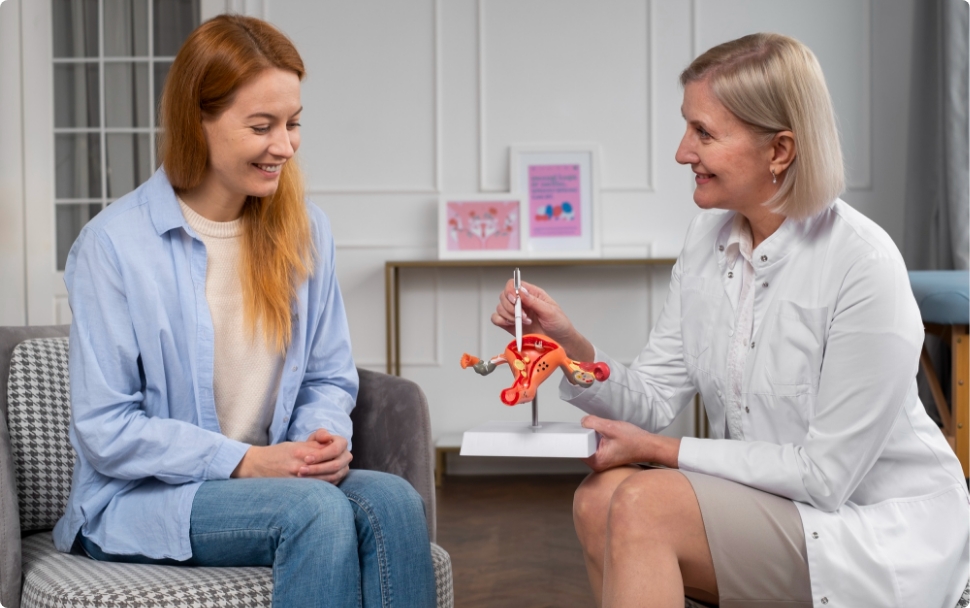Hormone Replacement Therapy is most often used to treat common menopausal symptoms, including hot flashes and vaginal discomfort. Hormone Replacement therapy has also been proved to prevent bone loss and reduce fracture in postmenopausal women. As you begin to transition into menopause, your ovaries no longer produce high levels of oestrogen and progesterone. Changes in these hormone levels can cause uncomfortable symptoms. Whether or not you should consider taking hormone replacement therapy is a discussion to have with your healthcare provider. There are many health benefits and risks associated with taking hormone replacement therapy.

What are the types of hormone replacement therapy (HRT)?
There are two main types of hormone replacement therapy (HRT):
Oestrogen Therapy: Oestrogen is taken alone. Doctors most often prescribe a low dose of oestrogen to be taken as a pill or patch every day. Oestrogen may also be prescribed as a cream, vaginal ring, gel or spray. You should take the lowest dose of oestrogen needed to relieve menopause symptoms and/or to prevent osteoporosis.
Oestrogen Progesterone/Progestin Hormone Therapy (EPT): Also called combination therapy, this form of HRT combines doses of oestrogen and progesterone (or progestin, a synthetic form of progesterone).
For patients who have had their uterus removed, there will be a difference in deciding what type of Hormone Replacement Therapy that should be taken. If you have had a hysterectomy, progesterone is typically not prescribed because oestrogen alone has fewer long-term risks than HRT that uses a combination of both oestrogen and progesterone. If you still have your uterus then progesterone is used along with oestrogen. Taking oestrogen without progesterone increases your risk for cancer of the endometrium (the lining of the uterus). During your reproductive years, cells from your endometrium are shed during menstruation. When the endometrium is no longer shed, oestrogen can cause an overgrowth of cells in your uterus, a condition that can lead to cancer. Progesterone reduces the risk of endometrial (uterine) cancer by making the endometrium thin. If you take progesterone, you may have monthly bleeding, or no bleeding at all, depending on how the hormone therapy is taken. Monthly bleeding can be lessened and, in some cases, eliminated by taking progesterone and oestrogen together continuously.
Risks/Benefits
What are the benefits of taking hormone replacement therapy (HRT)?
Hormone replacement therapy (HRT) is prescribed to relieve menopausal symptoms including:
- Hot flashes.
- Vaginal dryness that can result in painful intercourse.
- Other problematic symptoms of menopause, such as night sweats and dry, itchy skin.
Other health benefits of taking HRT include:
- Reduced risk of developing osteoporosis and reduced risk of breaking a bone.
- Improved mood and overall sense of mental well-being in some women.
- Decreased tooth loss.
- Lowered risk of colon cancer.
- Lowered risk of diabetes.
- Modest improvement in joint pains.
- Lower death rate for women who take hormone therapy in their 50s.
What are the risks of taking hormone replacement therapy (HRT)?
While hormone replacement therapy (HRT) helps many women get through menopause, the treatment (like any prescription or even non-prescription medicines) is not risk-free. Known health risks include:
- An increased risk of endometrial cancer (only if you still have your uterus and are not taking a progestin along with oestrogen).
- Increased risk of blood clots and stroke.
- Increased chance of gallbladder/gallstone problems.
- Increased risk of dementia if hormone replacement therapy is started after midlife. HRT started during midlife is associated with a reduced risk of Alzheimer’s disease and dementia.
- Increased risk of breast cancer with long-term use.
Hormone therapy (HT) is not usually recommended if you:
- Have or had breast cancer or endometrial cancer.
- Have abnormal vaginal bleeding.
- Have had blood clots or are at high risk for them.
- Have a history of stroke, heart attack or increased risk for vascular disease.
- Know or suspect you’re pregnancy.
- Have liver disease
What are the side effects of hormone replacement therapy (HRT)?
Like almost all medications, hormone replacement therapy has side effects.
The most common side effects are:
- Monthly bleeding (if you have a uterus and take cycled progestin [estrogen for 25 days of estrogen/month, progesterone for last 10 to 14 days/month, 3 to 6 days of no therapy]).
- Irregular spotting.
- Breast tenderness.
- Mood swings.
Less common side effects of hormone therapy include:
- Fluid retention.
- Headaches (including migraine).
- Skin discoloration (brown or black spots).
- Increased breast density making mammogram interpretation more difficult.
- Skin irritation under oestrogen patch.
The decision to take hormone replacement therapy needs to be a very personalized one. HRT is not for everyone. Discuss the risks and benefits of hormone replacement therapy with your healthcare provider at an office visit. Factors considered should be your age, family history, personal medical history and the severity of your menopausal symptoms. Be sure to talk about the pros and cons of the different types and forms of HRT as well as non-hormonal options such as dietary changes, exercise and weight management, meditation and alternative options.





